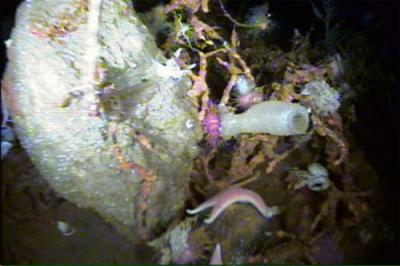One step forward, two steps back is how it feels sometimes - but progress is being made!
On October 16th the guys went out to try and get the transducer "unstuck” from the ice. This took a funnel and some hot water being sent down the iced-over hole. Meanwhile, Stacy and Nick were diving below the ice and took the bulkier end of the transducer off underwater so the cable could be pulled up more easily. With teamwork it finally came free!
The next day (yesterday) the guys drilled 5” holes in the ice (instead of the smaller 2” holes that froze over) and six entire flights got frozen in the hole before they could finish drilling it out! So 18’ of metal flights are now frozen in the ice.

You see the top of the stack - picture 18 more feet of flight below the ice!
So today started out with "two steps back" with Bob, Marcus and Nick trying to extract the stack of six flights frozen in the sea ice. They tried 220 F water, big wrenches, swearing, and a few other creative ideas, but the flights remained stuck.
In order to take at least one step forward, the team decided to use the hole from the fish hut next door to send one of the transducers down (instead of using the stuck-flight hole they had been drilling for it) so they could test the navigation system of the submersible.

The fish hut (left) is close to the dive hut. Our Tucker is in front of the dive hut.
Instead of using SCINI to test the navigation system, they put in a VideoRay from Marcus’s company. See www.videoray.com for more information about VideoRays. This was VideoRays first dive in Antarctica!

Bob lowering VideoRay into the dive hut hole.
Taking another step or two forward, they used the newly remodeled Tucker as dive-command center for the operation. Look closer and you can see...

...the generator and cables running from the transducers and power supply into the Tucker cab.
So what is going on in the back of the Tucker?

Open the door and let's see...

Stacy, Marcus and Bryan in command-central.
Thanks to Christian from the "carp" shop, there is a beautiful wooden shelf to put the computers and monitors on. Now we are at least three steps forward for the day.

Marcus flying the VideoRay and checking out the undersea life via VideoRays "eyes".
Notice our nice curtains to block out the sun so we can see the monitors. The VideoRay took some great footage of the sea floor and everyone had a blast flying it underwater - except for me because I am a chicken-weeny and was afraid I'd bury it in the silt or hit one of the pilings!

VideoRay Image: Starfish noshing on the bag of bones that Stacy left under the jetty.

VideoRay Image: This polychaete (bristle worm) is called Flabelligera. That name seems to suit it; we could call him "Flabby" for short.

VideoRay Image: An Under Ice Garden!


Comments